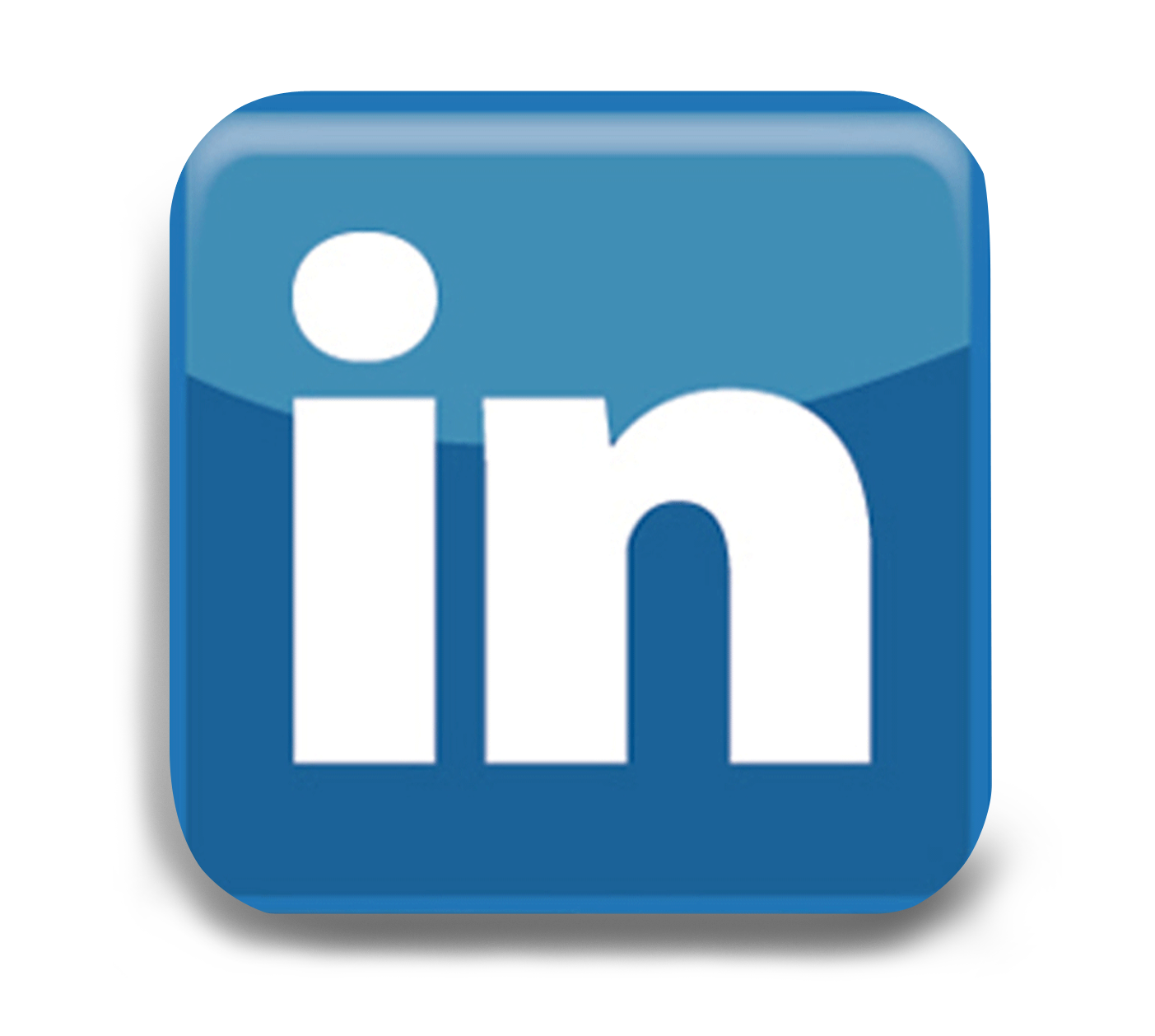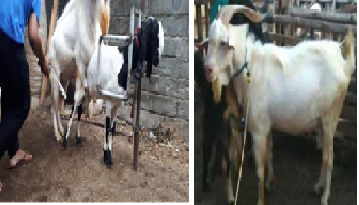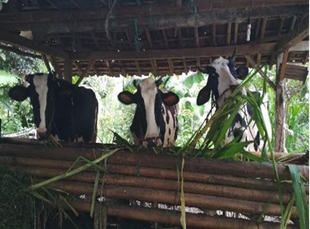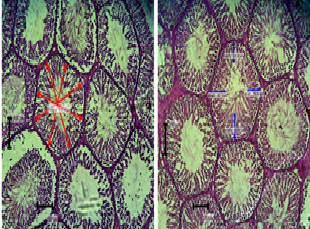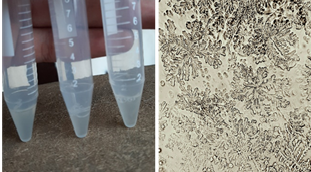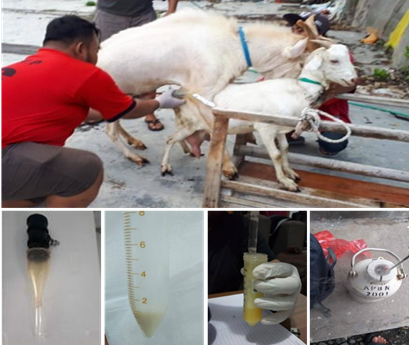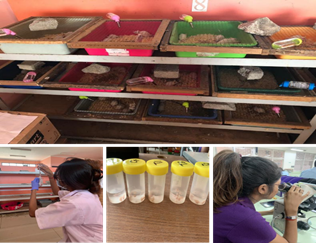Uterine torsion in Simmental crossbreed cow

Downloads
This case report describes the treatment of uterine torsion in Simmental crossbreed cattle. The dam was five years old, twice parity, in nine months and ten days pregnancy. Based on the anamnesis, it is known that the cows show signs of restlessness, straining, more robust by the time. However, there was no visible edema in the vulva, no ruptured membranes, no legs and head of the fetus coming out of the dam's vulva. Tretment was carried out by traditional rolling until the maximum uterine lumen opening was obtained. The position of the fetus is head flexion posture, so to remove it vaginally, the head is repositioned first and then forced to pull it out until the fetus comes out. Post-treatment, the dam's condition was still weak, unable to stand up, did not want to eat, and only drank a little. The drugs given were analgesics-antipyretics (repeated in the afternoon), long-acting antibiotics, vitamin B1, and vitamins and minerals mixed. After a few hours, the dam was up and walking around, feeding and drinking, and the placenta completely separated. The fetus's condition was alive, female sex, weak condition, the condition improves after being given milk from the dam. It can be concluded that the case of uterine torsion in Simmental crossbreed cows has been successfully treated 24 hours after the signs of birth using the traditional rolling technique, and the fetus can be expelled vaginally. The condition of the dam and fetus after the treatment of uterine were torsion gradually became healthy.
Amer HA, Hashem MA, Bader A. (2008): Uterine twisting during pregnancy in buffaloes; relationship between clinical finding and biochemical indices. J. Appl. Biol. Sci. 2, 31-39.
Aubry P, Warnick LD, DesCí´teaux L, Bouchard E. 2008. A study of 55 field cases of uterine torsion in dairy cattle. Can Vet J. 49(4):366-72.
Awaludin A, Nugraheni YR, Nusantoro S. 2017. Teknik handling dan penyembelihan hewan qurban. Jurnal Pengabdian Masyarakat Peternakan 2 (2): 84-97
Bai T, Diraviyam T, Zhou Z, Jiang Z, Zhang X. 2016. A comparative study of two uterine torsion correction methods in parturient cows. Veterinarski Arhiv 86 (6), 787-793
Beltman M. 2013. A novel twist to uterine torsion and abomasal displacement in dairy cows. Vet J 196: 284-285
Chaney, K.P., Holcombe, S.J., LeBlanc, M.L., Hauptman, J.G., Embertson, R.M., Eric Mueller, P.O. and Beard, W.L. 2007. The effect of uterine torsion on mare and foal survival: A retrospective study 1985–2005. Equine Veterinary Journal 39: 33–36.
Drost M. Complications during gestation in the cow. Theriogenology 2007; 68: 487-491.
Erteld E, Krohn J, Dzhakupov IT, Wehrend A. 2014. Uterine torsion in cattle--therapy and consequences for calf and cow. Tierarztl Prax Ausg G Grosstiere Nutztiere.42(5):297-303.
Erteld E, Wehrend A, Goericke-Pesch S. 2012. Uterine torsion in cattle - frequency, clinical symptoms and theories about the pathogenesis. Tierarztl Prax Ausg G Grosstiere Nutztiere.40(3):167-75
Faria N and Simíµes J. 2015. Incidence of uterine torsion during veterinary-assisted dystocia and singleton live births after vaginal delivery in Holstein-Friesian cows at pasture, Asian Pacific Journal of Reproduction, 4 (4):309-312.
Gevrekci Y, Akbas Y, Kizilkaya K. 2011. Comparison of different models in genetic analysis of dystocia. Kafkas Univ Vet Fak Derg 17: 387-392.
Ghuman SPS. 2010. Uterine torsion in bovines: a review. Indian Journal of Animal Sciences 80(4): 289-305
Jeengar K, Choudhary V, Maharia S, Vivekanand, Purohit GN. 2015. A retrospective study on type and extent of uterine torsion in buffaloes. Res. J. Vet. 3, 25-28.
Klaus-Halla D, Mair B, Sauter-Louis C, Zerbe H. Torsio uteri beim Rind: Uterine torsion in cattle: Treatment, risk of injury for the cow and prognosis for the calf. Tierarztl Prax Ausg G Grosstiere Nutztiere. 2018 Jun;46(3):143-149. German. doi: 10.15653/TPG-170680. Epub 2018 Jun 14. PMID: 29902813.
Laven R, Howe M. Uterine torsion in cattle in the UK. Vet Rec 2005; 157: 96.
Lyons N, Gordon P, Borsberry S, Macfarlane J, Lindsay C, Mouncey J. Clinical Forum: Bovine uterine torsion: a review. Livestock 2013b; 18: 18-24.
Lyons NA, Knight-Jones TJD, Aldridge BM, Gordon PJ. Incidence, management and outcomes of uterine torsion in UK dairy cows. Cattle Pract 2013a; 21: 1-6.
Mane PM and Bhangre RD. Outcome of different regimes of treatment for uterine torsion in bovine at field level – A clinical study .Indian Journal of Animal esearch.2015.(49):819-822
Maninderjeet Singh, S., Mohinderpal, S., Mandeep, S. and Ajeet Kumar. 2018. Torsion of the pregnant uteus with ascitic fetus in a Murrah Buffalo: A case report. Indian Vet. J., 95(01): 73-74.
Mee JF, Berry DP, Cromie AR. Risk factors for calving assistance and dystocia in pasture-based Holstein-Friesian heifers and cows in Ireland. Vet J 2011; 187: 189-194.
Noakes DE, Parkinson TJ, England GCW. 2009b. Maternal dystocia: causes and treatment. In: Veterinary Reproduction and Obstetrics, 9th ed. W. B. Saunders Company, USA, pp. 232-246.
Olmos G, Mee JF, Hanlon A, Patton J, Murphy J, Boyle L. 2009. Peripartum health and welfare of Holstein-Friesian cows in a confinement-TMR system compared to a pasture-based system. Anim Welf 18: 467-476.
Purohit GN, Barolia Y, Shekhar C, Kumar P. 2011. Maternal dystocia in cows and buffaloes: a review. Open J. Anim. Sci. 1, 41-53.
Schönfelder A, Hasenclever D. 2005a. Cost-utility analysis of surgical obstetrics in cattle with torsio uteri intra partum. Berl Munch Tierarztl Wochenschr. 118(11-12):490-4.
Schönfelder A, Schrödl W, Krüger M, Richter A, Sobiraj A. 2006a. Plasma haptoglobin concentration in cattle with surgically corrected torsio uteri intrapartum. Berl Munch Tierarztl Wochenschr.;119(1-2):81-5.
Schönfelder A, Schrödl W, Krüger M, Richter A, Sobiraj A. 2005b. The change of acute phase protein haptoglobin in cattle during spontaneous labor and Caesarean section with or without torsio uteri intrapartum]. Berl Munch Tierarztl Wochenschr. 118(5-6):240-6.
Schönfelder A, Sobiraj A. 2005c. Etiology of torsio uteri in cattle: a review. Schweiz Arch Tierheilkd. 147(9):397-402.
Schönfelder AM, Sobiraj A. 2006b. Cesarean section and ovariohysterectomy after severe uterine torsion in four cows. Vet Surg. 35(2):206-10.
Sickinger M, Erteld EM, Wehrend A. 2020. Fertility following uterine torsion in dairy cows: A cross-sectional study. Vet World. 13(1):92-95
Thangamani A, Srinivas M, Chandra Prasad B. 2018a. Pathophysiological Changes Following Uterine Torsion in Bovines - A Review. Int. J. Pure App. Biosci. 6 (2): 872-876
Thangamani A, Srinivas M, Prasad BC, Anusha K, Rao KS, Kumar LP. 2018b. Unraveling the mystery of uterine torsion in bovines: a review. International Journal of Science, Environment and Technology 7(2): 561 – 568.
Thangamani, A., Chandra Prasad, B., Sriniva, M., Anusha, K., Sadasiva Rao, K. 2017. Recurrence of uterine torsion associated with roomy abdomen and sex of the fetus: A novel case report. RRJoVST 6(3): 19-21.
Copyright (c) 2022 Sri Rahayu

This work is licensed under a Creative Commons Attribution-ShareAlike 4.0 International License.
Ovozoa by Unair is licensed under a Creative Commons Attribution-ShareAlike 4.0 International License.
1. The journal allows the author to hold the copyright of the article without restrictions.
2. The journal allows the author(s) to retain publishing rights without restrictions
3. The legal formal aspect of journal publication accessibility refers to Creative Commons Attribution Share-Alike (CC BY-SA).
4. The Creative Commons Attribution Share-Alike (CC BY-SA) license allows re-distribution and re-use of a licensed work on the conditions that the creator is appropriately credited and that any derivative work is made available under "the same, similar or a compatible license”. Other than the conditions mentioned above, the editorial board is not responsible for copyright violation.










